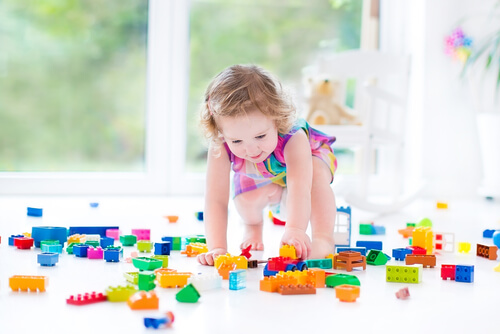Motor Development in Children 0-5 Years Old

From neonatal reflexes to writing sentences, motor development in children 0 to 5 years old is a stage of evolution and lifelong learning, both for them and their parents.
During this period, a series of changes in motor skills promotes the coordination of bones, muscles, tendons and nerves. The ability to walk on two legs and the precision to pick things up are two skills that define human beings.
These motor skills begin to develop at birth, and key organs become involved, including:
- Brain
- Spinal cord
- Peripheral nerves
- Muscles
- Joints
The nervous system, responsible for motor development, matures in a pre-established order. The sequence is clear and predictable, so it allows parents to monitor it and detect possible anomalies.
The first sign of motor development in children
The first sign of motor activity is in the head. The newborn can turn it from side to side when it is face up. If the newborn is face down, on the other hand, he can lift it a little.
Little by little, the baby will develop the movement of his hands, essential for motor development in children from 0 to 5 years old.
There are several stages the child goes through. When born, on average a baby will measure 50 centimeters and weigh 3.5 kilograms.
He has a big head and eyes, a small nose, fat cheeks and a cleft chin. From there, the curve of physical, cognitive, psychological and social development begins.
The motor development of children involves key organs, such as the brain, spinal cord, peripheral nerves, muscles and joints.
From the age of two months, hand-eye coordination begins. The child sees an object and tries to take it, and with practice he will manage to catch it.
Smiling and sticking out his tongue
From three months to one year of age, we can differentiate between three well-marked stages in terms of the child’s motor development.
- At three months, the baby begins to smile and stick out his tongue. He is able to stay seated with support. Babbling also begins. He keeps his hands open and holds an object with his fingers and in the palm of his hand.
- After six months, he starts to crawl and sits without help. A few months later, he will be able to stand and take steps. Although clumsily, he takes objects with both hands and releases them. He can also direct his hands to the opposite side of his body.
- At around the one-year mark, independence and curiosity increases. He puts everything in his mouth, so this is a risky stage.

Assisted walking
After a year, he’ll discover stairs, which he can climb with help. He’ll build towers with blocks and push and pull a ball with his hands and feet. He’s also able to pick up objects with his thumb and forefinger.
He begins to eat on his own and sits in a small chair. His autonomy increases, but so do his tantrums and jealousy.
At two years old, he goes up and down stairs alone, jumps with two feet, kicks a ball or rides a tricycle. His social and cognitive development increases, and he interacts more with other children.
He’s able to draw lines and flip through books. He feeds himself with a spoon and forms phrases, although sometimes they’re incoherent.
On the run
Running fast, copying a circle or standing on one foot are skills that develop after three years. He can cut with scissors, put together a three-piece puzzle, slide down a slide and walk on tiptoe.
At four years old, he can stand on one foot for a longer time. He can jump, climb and dance with skill. He can lean over and touch the floor with his hands and open a lock with a key. He can express thoughts, perfect drawings and play collaborative games.

5 years old: already writing words
After five years, your child will be able to descend stairs with one foot on each step. He can copy triangles, numbers and simple words in uppercase and lowercase letters. He can also tie knots and follow lines with scissors. He can also write sentences.
At this age, your child can change direction while running and walk on a narrow board while maintaining balance. He can also jump backwards.
Lateral dominance appears
Your child will also begin to establish a preference for one hand, eye and foot, known as lateral dominance. If he can use both sides equally, it is known as ambidexterity.
Motor skills in children will develop into a range of acts during 0 to 5 years. Precision, endurance, speed, coordination and strength will increase during growth.
From neonatal reflexes to writing sentences, motor development in children 0 to 5 years old is a stage of evolution and lifelong learning, both for them and their parents.
During this period, a series of changes in motor skills promotes the coordination of bones, muscles, tendons and nerves. The ability to walk on two legs and the precision to pick things up are two skills that define human beings.
These motor skills begin to develop at birth, and key organs become involved, including:
- Brain
- Spinal cord
- Peripheral nerves
- Muscles
- Joints
The nervous system, responsible for motor development, matures in a pre-established order. The sequence is clear and predictable, so it allows parents to monitor it and detect possible anomalies.
The first sign of motor development in children
The first sign of motor activity is in the head. The newborn can turn it from side to side when it is face up. If the newborn is face down, on the other hand, he can lift it a little.
Little by little, the baby will develop the movement of his hands, essential for motor development in children from 0 to 5 years old.
There are several stages the child goes through. When born, on average a baby will measure 50 centimeters and weigh 3.5 kilograms.
He has a big head and eyes, a small nose, fat cheeks and a cleft chin. From there, the curve of physical, cognitive, psychological and social development begins.
The motor development of children involves key organs, such as the brain, spinal cord, peripheral nerves, muscles and joints.
From the age of two months, hand-eye coordination begins. The child sees an object and tries to take it, and with practice he will manage to catch it.
Smiling and sticking out his tongue
From three months to one year of age, we can differentiate between three well-marked stages in terms of the child’s motor development.
- At three months, the baby begins to smile and stick out his tongue. He is able to stay seated with support. Babbling also begins. He keeps his hands open and holds an object with his fingers and in the palm of his hand.
- After six months, he starts to crawl and sits without help. A few months later, he will be able to stand and take steps. Although clumsily, he takes objects with both hands and releases them. He can also direct his hands to the opposite side of his body.
- At around the one-year mark, independence and curiosity increases. He puts everything in his mouth, so this is a risky stage.

Assisted walking
After a year, he’ll discover stairs, which he can climb with help. He’ll build towers with blocks and push and pull a ball with his hands and feet. He’s also able to pick up objects with his thumb and forefinger.
He begins to eat on his own and sits in a small chair. His autonomy increases, but so do his tantrums and jealousy.
At two years old, he goes up and down stairs alone, jumps with two feet, kicks a ball or rides a tricycle. His social and cognitive development increases, and he interacts more with other children.
He’s able to draw lines and flip through books. He feeds himself with a spoon and forms phrases, although sometimes they’re incoherent.
On the run
Running fast, copying a circle or standing on one foot are skills that develop after three years. He can cut with scissors, put together a three-piece puzzle, slide down a slide and walk on tiptoe.
At four years old, he can stand on one foot for a longer time. He can jump, climb and dance with skill. He can lean over and touch the floor with his hands and open a lock with a key. He can express thoughts, perfect drawings and play collaborative games.

5 years old: already writing words
After five years, your child will be able to descend stairs with one foot on each step. He can copy triangles, numbers and simple words in uppercase and lowercase letters. He can also tie knots and follow lines with scissors. He can also write sentences.
At this age, your child can change direction while running and walk on a narrow board while maintaining balance. He can also jump backwards.
Lateral dominance appears
Your child will also begin to establish a preference for one hand, eye and foot, known as lateral dominance. If he can use both sides equally, it is known as ambidexterity.
Motor skills in children will develop into a range of acts during 0 to 5 years. Precision, endurance, speed, coordination and strength will increase during growth.
All cited sources were thoroughly reviewed by our team to ensure their quality, reliability, currency, and validity. The bibliography of this article was considered reliable and of academic or scientific accuracy.
- Madrona, P. G. (2004). Desarrollo psicomotor en educación infantil (0-6 años). Wanceulen SL.
- Cratty, B. J. (1979). Perceptual and motor development in infants and children. https://eric.ed.gov/?id=ED164540
- Wade, M. G., & Whiting, H. T. A. (Eds.). (1986). Motor development in children: Aspects of coordination and control. M. Nijhoff.
This text is provided for informational purposes only and does not replace consultation with a professional. If in doubt, consult your specialist.








